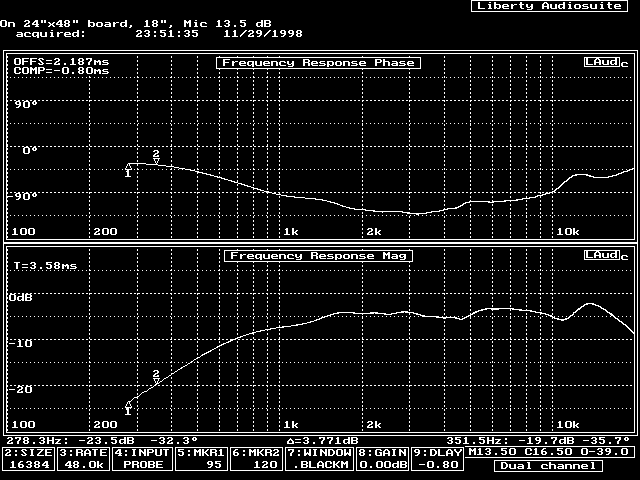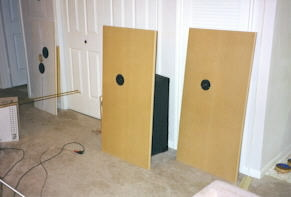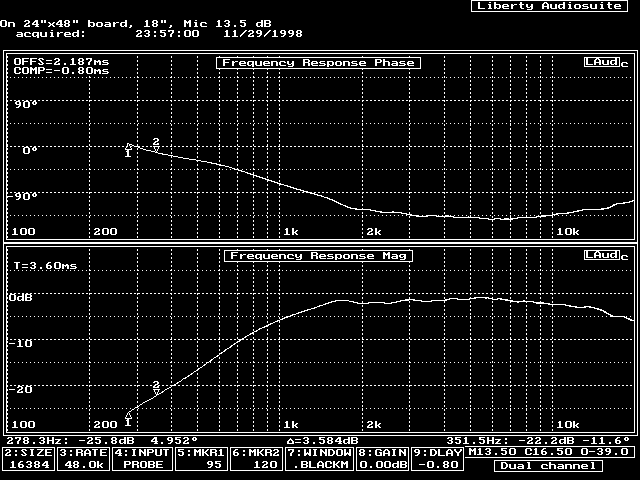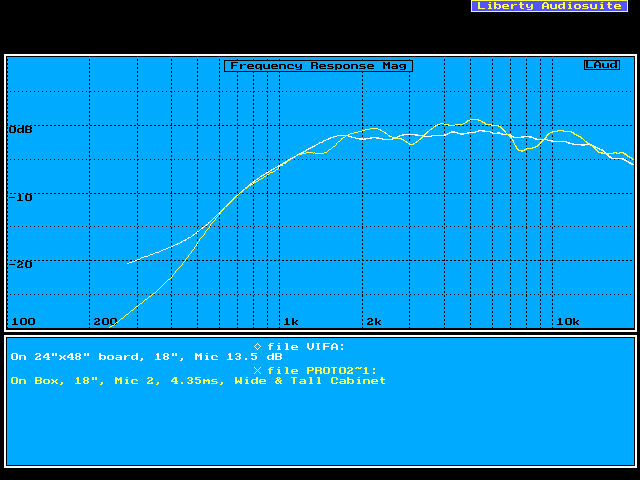 As mentioned in earlier tweeter testing , I wanted to revisit some of my tests of the Vifa D27SG-05 and the Morel MDT-30-S. I was suspicious of the foam board introducing measurement anomylies that were not part of the tweeters’ natural responses.
As mentioned in earlier tweeter testing , I wanted to revisit some of my tests of the Vifa D27SG-05 and the Morel MDT-30-S. I was suspicious of the foam board introducing measurement anomylies that were not part of the tweeters’ natural responses.
Testing Methodology, Mark II
 |
Testing environment is as before, in the corner of my apartment’s living room. I found some 2’x4’x3/4″ MDF boards at my local Home Depot store. Since they would fit through the trunk of my BMW M3 (unlike a 4’x 8′ sheet), I bought a pair to make two, dedicated test baffles. The details:
- The tweeter locations were 9-1/8″ from the left baffle edge and 18-1/4″ from the top
baffle edge. That is, the ratios between the top/bottom and left/right edge
distances as the golden mean, 1.616 to 1.
I chooose the golden mean since previous tweeter testing with that ratio went well. - Each tweeter was recessed so the faceplate was flush with the baffle.
- The left/right baffle edges (but not the top/bottom edges) were rounded over
with a 1/2″ radius. - Mortite&trade caulk formed the seal between tweeters and baffles.
- The microphone was at a distance of 18″ from the baffle and at the same height as
each tweeter. The resulting 3.5ms anechoaic test window yields a lower test
frequency of 300 Hz.
Caution!
I should mention that MDF has very sharp edges. Combine this with a large sheet’s weight and a disaster is a possibility. When handling large sheets, I heartily recommend wearing leather gloves. For smaller pieces, I would not hold them such that if you loose control, the edge of the board will slide across your hand. Especially if working the piece with some type of power tool. Ouch!
Test Results
I didn’t have to do too much testing before I was convinced the Vifa tweeter was the better choice for Speaker III. The first plot is a comparison of the frequency responses of the Vifa (top, flat curve) and Morel (bottom, ugly curve).
The Morel shows two response dips, a narrow dip at about 12 kHz and a wide dip between 3-5 kHz. The dip at 12 kHz has a corresponding peak at 15 kHz. This is similar to the foam board test results.
The only anomyly in the Vifa response is a little bit of ripple, most likely from baffle diffraction since the same trends show up in the response of the Morel tweeter as well. The dips at 7 kHz and 14 kHz in the Vifa foam board tests are now absent. (Sorry, no comparison plots.) This suggests the foam board affected the first Vifa tweeter measurements; both samples show no response anomylies on the larger, solid MDF test baffle. The Morel is a different story; the response dips are similar in the new and the old tests. I’m a little stumped, and I don’t have a plan yet to become unstumped.
The astute surfer probably has noticed that the Morel response curve is about 2-3 dB lower than the Vifa response curve. Nothing special is going on; the Vifa is simply a little more efficient than the Morel and has a lower DC resistance (which translates into more power for the same amount of input voltage).
Vifa Magnitude and Phase

These are impressive plots, as were the corresponding time-domain and waterfall plots. They should be compared and constrasted with the tests done for prototype cabinet #2 .
Although only just a slightly smaller baffle, prototype cabinet #2 has two mid-ranges mounted in it that definitely affect the frequency response!
There is a downside to the Vifa, however. The response falls off in the upper octave by 3 dB at 20 kHz. Fortunately, this can be corrected in a crossover L-pad circuit.
Comparisons with Prototype Cabinet #2
Tweeter test baffle #2 is close in size to the front baffle of prototype cabinet #2. Yet, the tweeter measurements of prototype #2 show peaks and dips not present in these tests:

The major difference between these measurements are
- Prototype #2 is made from particle board, these test baffles are MDF.
- Prototype #2 has two mid-ranges present. Moreover, the mid-ranges are
equidistant from the tweeter.
I really doubt the first difference is significant. Thus, I submit that the presence of mid-ranges on the front baffle affects the response more than diffraction in these tests. It makes sense; the mid-ranges are quite a bit closer to the tweeter than the baffle edge. In fact, I spaced the mid-ranges equidistant from the tweeter. And I already showed placing the tweeter in the center of a baffle equidistant from the baffle edges was a poor choice.
Ooops! Cleary some mid-range baffle position experiments are in order for the future.
Morel Magnitude and Phase

The Future: Morel Tweaking
I haven’t completely given up on the Morel yet. I started surgery on one of the units.
Testing with the back-chamber (made of plastic, not metal, like the Vifa) removed has demonstrated the shape of and damping material in this chamber noticably affect the response.
